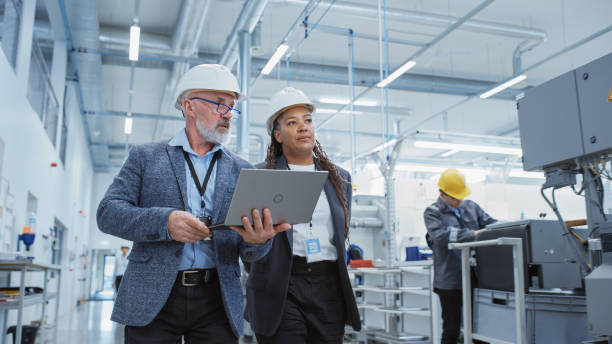Collaborative Robotics: Redefining Human-Machine Synergy
The convergence of advanced robotics and human expertise is revolutionizing industrial operations. Collaborative robotics, or cobots, are emerging as a game-changing technology that bridges the gap between traditional automation and human-centric workflows. This innovative approach to manufacturing and production processes is reshaping the industrial landscape, offering unprecedented flexibility, efficiency, and safety.

The Evolution of Industrial Robotics
The journey of industrial robotics began in the 1960s with the introduction of the first programmable robot arm. These early robots were large, expensive, and primarily used in automotive manufacturing. They operated in caged environments, separate from human workers, due to safety concerns. Over the decades, advancements in sensor technology, machine learning, and materials science have paved the way for more sophisticated and versatile robotic systems.
The concept of collaborative robotics emerged in the late 1990s, driven by the need for more flexible and human-friendly automation solutions. Early cobots were designed with built-in force limitations and rounded edges to ensure safe human interaction. As technology progressed, cobots became more intelligent, incorporating advanced sensors and adaptive algorithms that allow them to respond to their environment in real-time.
Key Features of Collaborative Robots
Collaborative robots are distinguished by several key features that set them apart from traditional industrial robots:
-
Safety-first design: Cobots are equipped with advanced sensors and force-limiting technology that allow them to detect human presence and adjust their behavior accordingly.
-
Ease of programming: Many cobots can be programmed through intuitive interfaces or even by physically guiding them through tasks, reducing the need for specialized programming skills.
-
Flexibility and adaptability: Cobots can be easily reprogrammed and redeployed for different tasks, making them ideal for dynamic production environments.
-
Compact and mobile: Their smaller footprint and lightweight design allow cobots to be easily moved between workstations as needed.
-
Human-centric interface: Cobots are designed to work alongside humans, complementing their skills rather than replacing them entirely.
Applications Across Industries
The versatility of collaborative robots has led to their adoption across a wide range of industries:
-
Manufacturing: Cobots assist in assembly lines, quality control, and material handling, working alongside human operators to improve efficiency and precision.
-
Healthcare: In medical settings, cobots are used for tasks such as surgical assistance, rehabilitation, and laboratory automation.
-
Agriculture: Collaborative robots are employed in tasks such as crop monitoring, harvesting, and sorting, helping to address labor shortages in the agricultural sector.
-
Logistics and warehousing: Cobots streamline order fulfillment processes, working alongside human pickers to improve accuracy and speed.
-
Automotive: Beyond traditional manufacturing roles, cobots are now used in vehicle customization and aftermarket modifications.
Economic Impact and ROI
The adoption of collaborative robotics has demonstrated significant economic benefits for businesses across various sectors. Studies have shown that cobots can lead to productivity gains of up to 50% in certain applications, while also improving product quality and consistency. The relatively low initial investment and quick deployment times of cobots result in faster return on investment compared to traditional automation solutions.
Moreover, the flexibility of cobots allows companies to automate processes that were previously too complex or variable for traditional robots. This opens up new opportunities for efficiency gains in small and medium-sized enterprises that may have found traditional robotics out of reach.
Challenges and Considerations
While the benefits of collaborative robotics are substantial, there are several challenges that organizations must address:
-
Workforce adaptation: Integrating cobots into existing workflows requires careful change management and employee training to ensure smooth adoption.
-
Safety regulations: As the technology evolves, regulatory frameworks must keep pace to ensure appropriate safety standards are maintained.
-
Cybersecurity: As cobots become more connected and data-driven, ensuring the security of these systems against potential cyber threats becomes crucial.
-
Ethical considerations: The increasing capabilities of cobots raise questions about the future of work and the ethical implications of human-machine collaboration.
Maximizing Cobot Integration
• Conduct a thorough assessment of your current processes to identify areas where cobots can add the most value
• Invest in comprehensive training programs for employees to ensure smooth integration and maximize the benefits of human-cobot collaboration
• Start with pilot projects to gain experience and build confidence before scaling up
• Regularly review and update safety protocols to address the unique challenges of human-robot collaboration
• Leverage data analytics from cobot operations to continuously optimize processes and identify new opportunities for improvement
As collaborative robotics continues to evolve, it promises to redefine the relationship between humans and machines in industrial settings. By embracing this technology, businesses can unlock new levels of productivity, flexibility, and innovation. The key to success lies in thoughtful implementation, ongoing adaptation, and a commitment to fostering a collaborative environment where human skills and robotic capabilities complement each other seamlessly. As we look to the future, the synergy between humans and cobots will undoubtedly play a crucial role in shaping the next era of industrial excellence.





